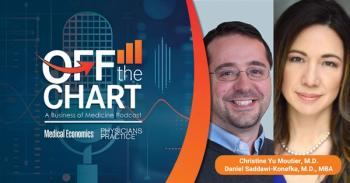
Can NPs and PAs Help or Harm Burned Out Physicians?
Everyone agrees that physician burnout is a major problem. What's less certain is the role that NPs and PAs can play in curing it.
Every new study seems to confirm it: Burnout is an ongoing problem in today's medical practice. The 2016 Survey of America's Physicians commissioned by the Physicians Foundation found that nearly half (49 percent) of 17,000 physicians surveyed reported feeling burnt out some or all of the time.
Burnout may result from a combination of factors including the Affordable Care Act (ACA), the introduction of EHRs, and other technology and unprecedented regulatory pressure, according to Catherine Miller, a senior risk management and patient safety specialist for the Cooperative of American Physicians, a provider of medical malpractice coverage in Los Angeles. "Historic stressors, including medicine's culture of invincibility and the disciplined and self-sacrificing nature of many practitioners, feed into the problem," she says. "The analogy to 'the perfect storm' is apropos."
Concurrent with growing stress levels in the doctor's workplace, the increasing availability of advanced practice clinicians brings a logical question: Can reliance on these professionals help lessen physician burnout?
Some practitioners see significant potential for PAs and NPs to reduce the burnout problem. Others, however, are not convinced.
In an informal February survey on SERMO, the social network for physicians, respondents were asked if they believed the use of PAs and/or NPs can help in reducing or avoiding physician burnout. Fifty-three percent indicated that they do help alleviate work load pressures, while 25 percent said that they create more work and confusion. Thirty-one percent of respondents reported having had issues supervising PAs and NPs in their practice. Some 28 percent indicated that their use raised questions of who has authority in the practice, and 13 percent reported an increase in feeling territorial about their work. At the same time, 27 percent reported that the use of PAs and NPs had a positive impact on their practice.
Load Sharing and More
Those who advocate for the use of PAs point out a number of advantages.
"Hiring a PA or and NP is an effective way to decrease a physician's workload, and it can have huge benefits for the practice," Miller said. She cites results such as improved patient satisfaction through reduced wait times and ultimately, a better patient experience. "A few extra unhurried minutes enjoying your patient's company is good for everyone," she says, adding that less time spent on routine tasks enables physicians to focus on patients with more complex needs.
"Reduction of work load is the number one way in which an [advanced practice clinician] can help reduce burnout," says Anthony Fisher, associate medical director of primary care for Sentara Medical Group in Hampton, Va. He cites tasks such as handling urgent-care visits, improving access by seeing see new patients in a timely fashion, and following up on hospital discharges as areas advanced practice clinicians can assist physicians. Working as a care partner with a physician to promote continuity of care can also be valuable in tasks such as educating a diabetic or following a myriad of chronic illnesses.
William Maples, chief medical officer for the Institute of Healthcare Excellence, a collaborative of health experts in Omaha, Neb., says that along with increasing the capacity to provide care, NPs and PAs may also foster effective teamwork.
"They can help create improved relationships among all members of the team with the patient at the center of the team," he says. "NPs and PAs can model compassionate and kind care, helping the entire health care team embrace behaviors which humanize care and connection to purpose."
Maples recalls that the use of a nurse practitioner in his former oncology practice proved to be a real benefit.
"The extension of high-quality, kind, and compassionate care to our patients allowed me to have better connections with all of the patients we served," he says. "In addition, the professional friendship of my nurse practitioner provided an avenue for emotional support in our daily work."
In her role as a NP in Porterville, Calif., Angela Vera Jackson has observed physicians being over-burdened with mounting paperwork and the increasing medical needs of aging baby boomers. She sees her work as important in allowing the physician to avoid feeling overwhelmed and consequently, less likely to suffer burnout.
"If we can attend to the less complex tasks, it gives the physician more time to allocate to patients who need additional attention," she says.
Jackson tells of a recent patient, himself a doctor, who had suffered a stroke. The workload relief provided by her position allowed the physician to take more time with a fellow doctor than might otherwise have been the case.
Bridget Duffy, chief medical officer for Vocera Communications, a provider of clinical communication solutions in San Jose, Calif., points to the potential for enhanced teamwork.
"Organizations where doctors and nurses, both RNs and NPs, and physician assistants all view themselves as equal and valued partners in patient care usually produce better results," she says.
Varying Viewpoints
Of course, as noted in the SERMO survey, some physicians are not convinced of the value of PAs and NPs in limiting burnout, at least on an across-the-board basis.
"Hiring an NP or PA to extend the skills or redirect some of the less demanding responsibilities of a physician may decrease the stress and burnout experienced by some, but may actually increase it for others," says Russell Libby, president and medical director of Virginia Pediatric Group in Fairfax, Va. and a Physicians Foundation board member. He points out that such partnerships may bring an increase in patient visits and associated responsibilities to worry about, with less of the customary control doctors are used to having.
"Physicians expect to control their universe of work and when that gets out of balance, they can experience stress," he says. "Most will have confidence in their own judgment, but being responsible for the actions, outcomes and potential liabilities of others can be overwhelming for some."
Libby says other approaches may be more cost effective and offer greater potential to reduce burnout. Options include using scribes to decrease the technology and data-entry burden, investing in care coordination using RNs who work to the top of their license to track and monitor complicated patients, and designing workflow models that let office staff relieve doctors from menial or redundant tasks.
Questions about quality should also be considered, according to Maples. "A NP or PA who is not qualified or has not been adequately trained can actually lead to less-than high quality care which can contribute to a further loss of connection to purpose," he says. One result can be that work needs to be redone and connections may be strained with patients, families, or fellow caregivers.
Fisher acknowledges that some providers are likely to become territorial toward NPs or PAs if they view them as rivals for patient visits rather than partners in caring for patients. But he advocates the latter. "As medicine moves more toward a population- based compensation system, they will be vital to efficiently and effectively care for a panel of patients in a cost-effective and quality manner," he says.
Leveraging for Success
For physicians who do engage APCs, Miller says it's important to appreciate the responsibilities and risks associated with their role as "supervising physician." In the hiring process, this includes verifying the employee's experience and credentials and notifying malpractice insurers to ensure there is coverage. Also critical is becoming thoroughly familiar with state laws and regulations that clarify the authority and scope of mid-level providers and any specific requirements for physician supervision.
"NPs and PAs cannot simply be dropped into the workplace, left unattended and expected to perform," Miller says. "I've known of situations where physicians, in their excitement at having the extra help, have prematurely deployed a midlevel provider without specifically defining their scope of practice or any practice limitations." Miller has also seen lack of a proper orientation to office policies and protocols and overall inattention to adequate supervision." Similarly, she has observed cases where physicians mistakenly attributed more clinical expertise or experience to a PA or NP than the individual actually had at that particular point in their career. In such instances not only can patient safety be jeopardized, but also the risk exposure increases for all concerned.
Miller advises gradually enfolding the NP or PA into practice and then steadily increasing his or her independence as clinical competence is demonstrated. A written agreement should be executed detailing the scope of practice and the nature of the supervisory relationship. Typical points to be covered include the types of patients the NPs or PAs can see, the procedures they can perform, mechanisms for escalating concerns about patients and emergency protocols, among other considerations.
She says an orientation for an NP or PA should cover essential patient safety protocols such as recall and tracking systems, call backs, protocols for addressing and documenting non-adherence and communicating and documenting labs. It should also address critical results and medical advice, managing and escalating patient complaints, improving health literacy, HIPAA, and the practice's social medical policy.
"It's a sizeable task," she says. "But providing a well-organized and comprehensive orientation serves everyone."
Newsletter
Optimize your practice with the Physicians Practice newsletter, offering management pearls, leadership tips, and business strategies tailored for practice administrators and physicians of any specialty.








